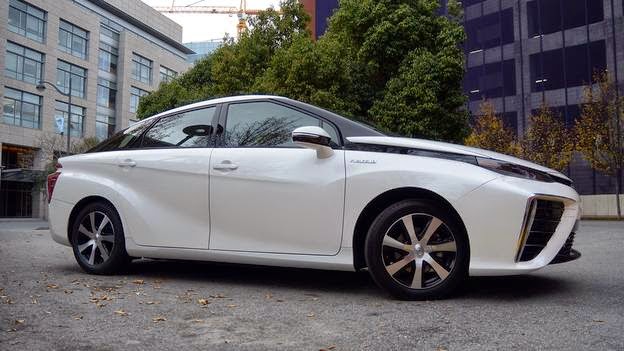The all new Toyota Mirai
As car companies go, Toyota has a good record of predicting – and dictating – consumer tastes. Consider two examples from its recent history: its ultra-reliable Camry has been the best-selling car in the US for the last 12 years, and its Prius hybrids were not merely the best-selling cars of their kind, but the best-selling vehicles, period, in California in 2012 and 2013.
In November 2013, Toyota announced a new vision, one that is more ambitious, and perhaps more fraught, than any other in the company's history. Fittingly, this vision is named after the Japanese word for “future,” Mirai. If the same executives who wagered on the Camry and Prius are to be trusted, then the future is hydrogen.I recently had the chance to take the future, as it were, for a quick spin in San Francisco. Unlike most new cars, whose computer-rendered carapaces conceal retrograde combustion technology, the Mirai’s swoopy bodywork cloaks a truly sophisticated power plant: a hydrogen fuel cell whose only emission is water vapour.
While the Mirai's fuel and powertrain are exotic, the ride borders on the unremarkable. The cabin, clad in plant-based leatherette and insulated from outside noise by acoustic glass, is sedate and uncluttered, with a slim digital dash reminiscent of the unit in a Prius. The only really striking interior feature is a touch-sensitive central console (though “slab” may be a better descriptor) housing intuitive controls for the car's climate and audio systems.
For a substantial car, at 192.5in (489cm) and 4,080lbs (1,850kg), the Mirai is nimble, pivoting easily round potholes on the intermittently pocked streets of San Francisco's industrial China Basin neighbourhood. When swerving was not an option, its suspension dispatched the divots with soft, satisfying thwops.
Toyota claims a range of up to 300 miles on 5kg of gaseous hydrogen, stored in two high-pressure tanks made from carbon fibre. The carmaker notes that a kilogram of hydrogen has the same energy content as a gallon of gasoline. So in broad strokes, the Mirai's fuel economy is equivalent to 60mpg, a rating which would best the Prius's 50mpg combined figure by 20%.
 Futuristic appeal and drinkable emissions aside, whether the world's first mass-produced fuel-cell car succeeds is a matter of timing and infrastructure. California, the global launch market for the Mirai, currently has just 10 hydrogen filling stations, versus 10,000 conventional petrol stations and more than 1,800 electric-vehicle charging stations. Then there's the matter of where the hydrogen comes from. Most hydrogen in the US derives from natural gas, the extraction of which can pollute the environment. But hydrogen can also be extracted from water using electricity generated from solar, wind and hydropower.
Futuristic appeal and drinkable emissions aside, whether the world's first mass-produced fuel-cell car succeeds is a matter of timing and infrastructure. California, the global launch market for the Mirai, currently has just 10 hydrogen filling stations, versus 10,000 conventional petrol stations and more than 1,800 electric-vehicle charging stations. Then there's the matter of where the hydrogen comes from. Most hydrogen in the US derives from natural gas, the extraction of which can pollute the environment. But hydrogen can also be extracted from water using electricity generated from solar, wind and hydropower.While the future of hydrogen is still somewhat murky, one thing is clear. If the Mirai is to succeed in the manner of its siblings, an enormous investment in hydrogen infrastructure is necessary. That the Mirai – a fully realised and perfectly personable car – is here to force the discussion is a minor miracle.
Source - http://www.bbc.com





Comments
Post a Comment